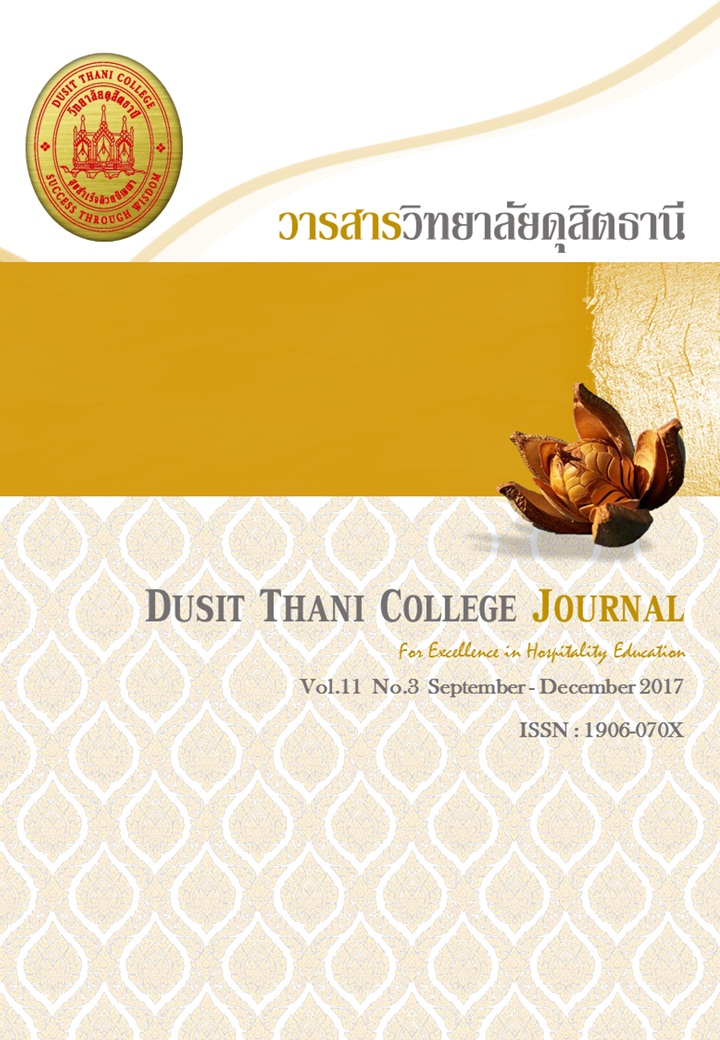Developing Model of Risk Management Capabilities Toward Organizational Performance of Higher Education Institutions in Thailand
Main Article Content
Abstract
This research aims to 1) develop a model of risk management capabilities for organizational performance of higher education institutions in Thailand 2) estimate and test the model fit to data, and 3) determine to effect size of the model. The data were collected from 186 higher education institutions and analyzed by using SEM. It was found out that the model was fit to data. The chi-square associated with the model is significant, p-value is equal to 0.17, a chi-square/df ratio is equal to 1.14, comparative fit index of CFI, GFI, and AGFI is more than 0.90 and RMSEA is equal to 0.02. There is a total effect of resource support, risk management capabilities, transformation leadership, and organizational learning experiences on high performance success, respectively. In addition, there is a direct effect of resource support, and risk management capabilities on high performance success. While there is also an indirect effect of resource support, transformation leadership, and organizational learning experiences on high performance success, respectively. Nevertheless, there is a direct effect and total effect of resource support, transformation leadership, and organizational learning experiences on risk management capabilities.
Article Details
Article Screening Policy
- All research and academic articles to be published must be considered and screened by three peer reviews in the relevant field / article.
- All articles, texts, illustrations and tables published in the journal are the personal opinions of the authors. Editors don't always have to agree. And no responsibility whatsoever is the sole responsibility of the author.
- The articles to be published must never be published. Where did you first publish? And not in the consideration of other journals If the audit found that there has been a duplicate publication It is the sole responsibility of the author.
- Any article that the reader sees as being plagiarized or impersonated without reference. Or mislead the work of the author Please let the journal editor know it will be your greatest blessing.
References
Bridging Organizational Learning Capability and Firm Performance through Customer Relationship Management. Social and Behavioral Sciences 150: 531-540.
Beatriz Fernández-Muñiz, José Manuel Montes-Peón, Camilo José Vázquez-Ordás (2014).
Safety leadership, risk management and safety performance in Spanish firms.
Safety Science, 70(December 2014), 295-307.
Beer, M. (2010). Managing Change and Transition. Harvard: Harvard Business School
Publishing.
Bentler, P.M. and Chou, C. (1987). Practical issues in structural modeling. Sociological
Methods and Research, 16, 78 - 117.
Chaiwong, varachok. (2006). Research and Development Professionals.Bangkok : n.p..
Christine Louise Maney Eick. (2003). Factors that Promote Effective Risk Management
at Universities Classified by The Carnegie System as Doctoral/Research Universities-Extensive. ProQuest Information and Learning Company.
Cronbach, L. J. (1970). Essentials of Psychological Test (5thed.). New York: Harper Collins.
Daft, R.L.(2001). Organization theory and design (7thed.).Maronville, Mo :Souts-Western College.
Diamantopoulos and Siguaw (2000). IntrodcingLisral. London: Sage Pubication.
Girotra, K. and Netessine, S. (2014). The Risk-Driven Business Model : Four Questions
that Will Define Your Company. Boston : Harvard Business Review Press.
Hair, J. F., Jr., Black, W. C., Babin, B. J., Anderson, R. E., & Tatham, R. L. (2006). Multivariate
data analysis. (6thed). Upper Saddle River, NJ: Prentice Hall.
Hillson D.A. (2013) Benchmarking risk management capability. Project & Business Risk Mgt,2 (2)
Honey, P., & Mumford, A. (1992). The manual of learningstyles (2nd ed.). Maidenhead,
UK: Peter Honeyand Alan Mumford.
Hoy and Miskel. (1991). Educational Administration: Theory, Research, and Practice.
5thed. New York, NY: McGraw-Hill.
Hoyt, E. R., and Liebenberg P. A. (2011). The Value of Enterprise Risk Management,
Journal of Risk and Insurance. 78, 795-822.
Jason Matthew Reley. (2013) Understanding the antecedent competencies of
organizational risk management capabilities. ProQuest Dissertations Publishing, 2013.
Johnson-Conley, Christina D. (2009). Using Community-based Participatory Research in
the Development of a Consumer-driven Cultural Competency Tool. Ph.D.
Dissertation, University of Washington Graduate School.
Khongsawatkiat, kittiphun. (2011). Fundamentals of Risk Management and Derivatives.
Bangkok : Pearson Education Indochina Ltd.
Mintzberg, Henry. (1971). The Structuring of Organizations. New Jersey: Prentice-Hall Inc,
Nunnally, J.C. (1978). Psychometric Theory. New York: McGraw-Hill.
Office for National Education Standards and Quality Assessment. (Public Organization).
List of Higher Education Institutions. (Online) Accessed April 8, 2015. Available fromhttps://www.onesqa.or.th.
Pallant, J. (2010). SPSS Survival Manual: A Step by Step Guide to Data Analysis Using
IBM SPSS. 4thed. Maidenhead: Open University: Press/McGraw-Hill.
Pollard et al. (2005). Risk management capabilities- Towards “Mindfulness” for the
international water utility sector. Proceeding of the Walter Contamination Emergencies: Enhansing Our Response conference.
Pattamatattanon, Nuttiya. (2010). Risk Management Affecting The Effectiveness of School
Under The Office of Pathumthani Education Service Area. RajamangalaUniversity of Technology Thanyaburi.
Prapawadee Na RanongWariya Phuenngam. (2009). Critical Success Factors for effective risk management procedures infinancial industriesA study from the perspectives of the financial institutions in Thailand. Umea School of Business.
Saardchom, Narumon. (2007). Risk Management. Bangkok :K.ponpim Press.
Sakhagron, Jantana. Henchokchaichana, Niphan. and Srijanphet, Silapapron. (2007).
Internal control and Internal Audit.Bangkok : TPN Press.
Waldman, D. A., Siegel, S. D. and Javidan, M. (2006). Components of CEO Transformational Leadership and Corporate Social Responsibility. Journal of Management Studies. 43(8), 1703-1725.
Weiner, B. J. (2009). A Theory of Organizational Readiness for Change. Accessed
February 17th, 2016, from https://www.implementationscience.com/content/4/1/67.
Wernerfelt B. (1984). A resource-based view of the firm. Strategic Management Journal,
5, 171-180.
Worley, C. and E. Lawler. (2006). Designing organizations that are built to change."
Sloan Management Reivew 48(1), 19-23.
Yang, L., Huang, C. and Wu, K. (2011). The association among project managers
leadership style, teamwork and project success. International Journal of Project
Management, 29(3), 258-267.


